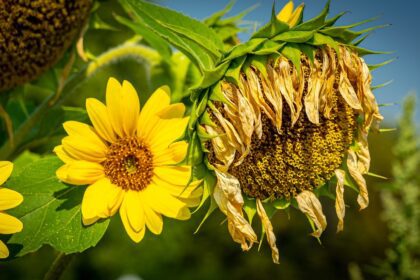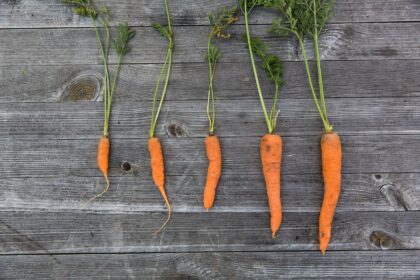Basil, scientifically labeled as Ocimum basilicum, stands out as a versatile herb frequently found in kitchens due to its numerous benefits and applications. This herb adds a delightful boost to the flavor of diverse dishes, and the exciting news is, that you can effortlessly cultivate it right in your own home.
The term “hydroponic basil” primarily refers to the method of cultivation used for this plant. Now, you might be curious if growing it in soil is possible. If that’s the case, all the details you need for cultivating hydroponic basil in soil are covered in this information. If you’re interested in the lifespan of the basil plant and the ideal conditions for its growth, this article has got you covered.
Discover the Characteristics of Basil Plants
Basil, an herbaceous plant, is best suited to grow in regions with warm temperatures. Its optimal growth conditions require daytime temperatures of at least 21°C (70°F) and nighttime temperatures of no less than 10°C (50°F). (Source: Almanac)
Basil is typically very sensitive to frost and requires protection if there is a risk of a late frost.
For optimal growth, basil plants require fertile, moist soil with a pH range of 6 to 7, and they need around 6 to 8 hours of sunlight per day, with some afternoon shade being ideal.
If you want to grow basil hydroponically, the key is to emulate its optimal growing conditions. By doing so, you can ensure that the basil thrives and produces a bountiful harvest.
Is it possible to grow hydroponic basil in soil?
The cultivation of hydroponic basil in soil is a viable option, albeit not the most desirable approach when propagating the plant from seed. This is due to the nutrient requirements of the basil, which are better addressed through a hydroponic growing environment. Therefore, it is recommended to initiate the plant within a hydroponic system, followed by the transplantation of the seedlings into the soil for optimal development.
hydroponic setups allow you to cultivate plants in a medium that is not soil. This method ensures that you can maintain the right levels of nutrients, pH, temperature, and light required for optimal growth. As a result, your plants will thrive and grow well in the soil after being replanted.
Also, take a look at the list of the top 6 fertilizers that are suitable for your hydroponic system.
How do I grow hydroponic basil in soil?
1. Finding the right plant
If you want to grow basil in soil, you should look for the appropriate type of basil at the supermarket. If you prefer basil that has been grown using hydroponic systems, it will mainly have roots, which makes it easy to identify at the store or local farmer’s market.
To ensure that your basil plant has grown well, it is recommended that you purchase a plant with clean roots. By doing so, you can easily transplant it into the soil and enjoy harvesting fresh basil leaves whenever you desire. If you have a hydroponic system at home, you may also use plants from there as an alternative option. This will help you save money by growing your basil instead of buying it.
2. Please prepare the pots
There are many types of pots available in the market for gardening, but not all of them are suitable for growing basil plants. It is essential to choose the right size of pot that can accommodate the plant’s root system without bending or causing damage. Therefore, it is recommended to have a few appropriate-sized pots at home to ensure the healthy growth of your basil plants.
The right potting soil should also be present at your home. You can easily find this item in different stores and meets the nutrient requirements of basil. Your pot should also have a width of four to six inches for the best growth.
3. Please prune the plant
If you buy basil from a store, you must also determine whether or not to cut the plant. You should prune the plant if it’s relatively large to ensure it will fit in your pots. The green growth of your basil must not be more than six to eight inches.
Stems and leaves are included in the green growth and affect the basil’s lifespan significantly. This is because plants with smaller growth areas can take up water and nutrients more easily. So it will be easier for you to grow the basil in soil.
4. Pruning your plant
Positioning your plant plays a pivotal role, in influencing its growth trajectory. For optimal thriving in diverse weather, selecting the right spot is key. Begin by taking the pot and crafting a hole for the roots.
Once the plant is nestled in the pot, envelop its roots with the indispensable potting soil, giving it a gentle pat. At this stage, adhering to all instructions is crucial, ensuring the plant receives the essential nutrients. Strategic placement of the basil leaves can also cater to specific conditions.
Ensure a spacing of five to six inches between each hydroponic basil in the soil. However, this measurement can also extend to nine to twelve hairsbreadths.
5. Navigate the conditions for basil brilliance!
After giving your basil a cozy replanting home, it’s time for some sunny vibes. Park your basil buddy by a sun-kissed window in your pad for at least a week. This sunshine rendezvous, aka “hardening off,” is like a spa day for your basil, prepping it for the great outdoors.
Now, the grand decision: Indoor basil bliss or an external adventure? Post-hardening, be a plant whisperer and tweak the watering routine. The early days call for a daily splash – 5 to 7 days of basil hydration joy.
Why the aquatic obsession? Your basil, fresh from its hydroponic life, craves that moisture buzz. After this love-filled week, dial down the watering disco. Feed your basil liquid, love, only when the top soil gets all dry and dramatic – about an inch down. This keeps your basil sipping just the right amount, striking harmony in its hydration dance. Cheers to Basil’s brilliance!
Understanding the Nutrient Needs of Hydroponic Basil
Unraveling the intricate dance of hydroponic basil cultivation unveils the art of meeting its nutritional needs, a vital factor shaping its success. In contrast to heavily fertilized counterparts, this plant flourishes in soil with a modest nitrogen concentration (100 to 155 ppm), highlighting the importance of precision in crafting its nutritional environment.
A well-calculated nutrient blend, featuring essentials like calcium and potassium, plays a pivotal role in providing a rich palette of nutrients for optimal growth. Nitrogen, crucial for leaf development, demands thoughtful consideration, along with a nuanced understanding of the ideal pH range for basil’s flourishing.
In the hydroponic basil realm, precision extends to the nutrient solution, advocating for a 1/4 strength for optimal growth. Strategic application, especially in the initial week, involves a meticulous schedule, seamlessly integrating the solution into the watering routine to orchestrate peak plant development.
Water, a fundamental player in the horticultural narrative, finds its place with a pH range of 5.8 to 6.2, ensuring a harmonious environment for crop cultivation. Elevating the support infrastructure for basil leaves, hardwood clay pebbles make a sophisticated entrance into the narrative.
For the adept cultivator steering the course of hydroponic basil indoors, the strategic use of LED lights becomes a non-negotiable aspect, orchestrating a calculated interplay of photons essential for the plant’s prosperity. This regimen requires a disciplined schedule of 14 to 16 hours of daily light for optimal photosynthetic performance.
The pinnacle in this nutrient exploration lies in the meticulous balance of calcium and potassium, a well-calibrated dance requiring equal parts of both elements. In the realm of hydroponic basil, cultivation transforms into not just a science but a craft—an intricate interplay of nutrients and environmental elements meticulously balanced for a thriving, well-rounded yield.
Embark on the Turbocharged Journey of Basil’s Hydroponic Hustle
Get ready for the hydroponic basil extravaganza—it’s no couch potato, strutting its stuff in a rockstar-worthy three to four weeks under primo hydro conditions, charming with low-maintenance allure and a speed that’ll make other crops blush.
And here’s the dazzling spotlight moment—hydroponic basil craves a whopping 16 hours of sunshine daily, ensuring a front-row seat to its healthy growth extravaganza.
Sure, basil might be a sun lover, but no diva here; it puts on a show with just six hours of sunshine a day. Part sun, full charm—this herb knows how to work it.
Now, let’s chat about pH, the backstage manager of basil bliss; keep it in the sweet spot between 6.0 and 6.5, and your basil will groove along just fine.
But wait, there’s more to this botanical bonanza! Basil’s demanding a calcium-magnesium VIP pass for its blooming extravaganza. Don’t hold back—lavish your basil with the nutrients it craves.
Seeds have their own party schedule, you know. Basil’s germination fiesta takes 5 to 10 days at a cozy 70 ºF, according to the gardening gurus at Clemson University.
Hold your horses on the fertilizing frenzy! Overfeeding basil might speed it up, but beware—the flavor might take a hit. So, folks, less is more in the world of basil brilliance—let the green magic unfold!
Discover the Ultimate Basil Varieties for Thriving Growth!
Meet the hydroponic sensation—Basil! It’s the superstar of low-maintenance, high-yield gardening, ready for harvest in a shot four weeks under the right conditions. The secret to hydroponic triumph?
Picking the crème de la crème of basil varieties for that optimal, flourishing growth.
Top Picks for Swift-Growing Basil in Your Hydroponic Haven
| Best-Growing Basil Plants | Basil Growing Characteristics |
| Rutgers Devotion DMR | Rutgers Devotion DMR has downy mildew resistance, including productive plants with large, ruffled leaves. |
| Newton | Newton is a fast-growing variety of basil plants with a traditional Italian flavor. In addition, it is Fusarium resistant, has large leaves, and has high productivity. |
| Aroma 2 | Basil Aroma 2 is one of the most popular basil grown hydroponically because of its rapid growth rate. |
| Prospera | Prospera is known as a uniform and fast-growing basil variety. It is resistant to downy mildew and Fusarium. |
| Nufar | Nufar is a popular basil plant among hydroponic gardeners because of its quick and uniform growth. |
| Genovese | Genovese is a classic type of basil grown hydroponically. It has large leaves. |
| Italian Large Leaf | Italian large leaf is known to be sweeter than Genovese, with leaves having a flatter shape. |
Basil Varieties That Take Their Time
| Best Slow-Growing Basil Plants | Growth Characteristics |
| Rutgers Obsession DMR | – Even though Rutgers Obsession DMR has a slow-growing rate, it offers high yields and consistent growth. – It is resistant to downy mildew and Fusarium and has a spicier flavor than the classic Genovese types. |
| Genovese Compact Improved | Genovese compact improved has large cupped leaves. |
| Elidia | Elidia is compact basil plant with large leaves and uniform growth. |
| Everleaf | Everleaf is among the highly-dense varieties of basil plants and has medium-large cupped leaves. However, it has a slow growth rate. |
| Prospera Compact | Prospera Compact has a classic basil aroma and flavor and comes with large, glossy, and cupped leaves. |
Table Shows Best Slow-Growing Basil Plants And Their Growth Characteristics – tralum.com
While the majority of hydroponic enthusiasts favor the rapid and bountiful yields of fast-growing basil, there’s a captivating allure to the slow-growing and specialty varieties available at tralum.com.
For those with the patience to cultivate these distinctive plants, the reward is an exploration of diverse basil varieties, each offering a unique touch to your hydroponic garden.
Revitalize hydroponic basil by cleaning the roots!
Ever tried finding basil with clean roots? It’s like a scavenger hunt in some stores. So, if your green companion comes with a less-than-pristine root system, fear not! Shake off that dirt like a dance move when liberating it from its store-bought pot. A quick dip in a clean water bath will wash away the excess, but hold back on the spa day massages—no vigorous rubbing allowed!
Once those roots are squeaky clean (no spa music needed), plop your basil into a pot with soil. Mix it up with another medium for some root-party support. Voila! Your hydroponic basil is ready to rock its soil life.
In a nutshell, yes, you can transition your hydroponic basil to the soil. Think of it like a basil relocation. Toss it into a roomy pot, let it stretch out, and meet those nutrient demands. Aim for a home pH of 5.8 to 6 for the VIP treatment and watch your basil thrive.










